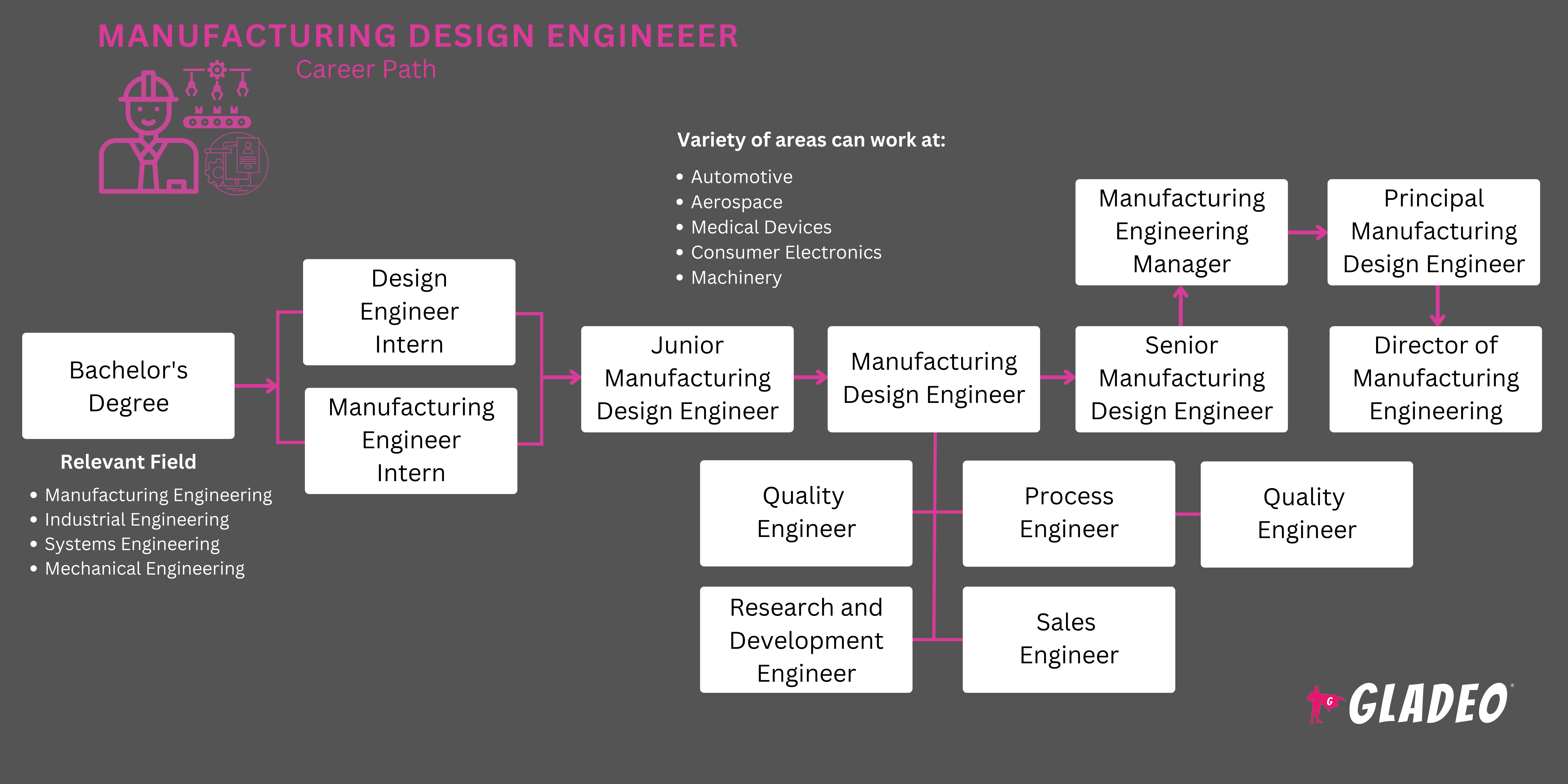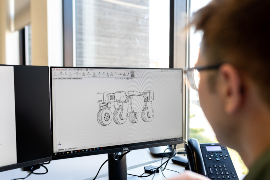聚光灯
制造工艺工程师制造系统工程师制造开发工程师制造生产工程师制造设计与开发工程师制造工艺开发工程师制造设计专家生产设计工程师工艺设计工程师制造设计分析师
如果你曾购买过大批量生产的产品,它很可能就是通过制造完成的。现代制造业依靠创新设计和高效流程,将创意转化为我们能在现实世界中使用的商品!
正因如此,制造业对众多行业至关重要——从汽车到家电及其他消费品,无一例外。而制造设计工程师正是让这一切成为可能的专家。
他们创建并实施将设计从概念阶段推进至生产所需的复杂流程,在确保产品品质与功能的同时,助力优化制造方法。
融合机械工程、材料科学与工业设计原理,他们的研究成果对制造商保持成本效益和竞争力至关重要。这最终将推动多行业更广泛的经济增长与技术进步!
- 创新产品设计与制造工艺
- 提升生产效率与可持续性
- 推动各行业的技术进步
工作日程
制造设计工程师通常全职工作,为满足项目截止日期需加班。该职位可能需要不定期出差,包括工厂考察、供应商会议及行业会议。
典型职责
- 与跨职能团队协作,共同开发并完善产品设计
- 为产品选择合适的材料和制造工艺
- 实施成本削减策略并提高生产效率
- 使用计算机辅助设计与制造软件进行产品和工艺模拟
- 审查产品质量并监督原型测试
- 分析生产数据以发现问题和低效环节
- 为制造团队提供技术指导和支持
- 保持关于制造过程的详细记录
- 及时了解与制造业相关的趋势和技术发展动态
- 整合自动化和机器人技术等新技术
- 研究行业最佳实践,主导持续改进
计划,并专注于精益制造原则
额外职责
- 与供应商合作,确保合适材料的供应
- 参与研究与开发
- 评估环境影响;确保符合行业标准
- 与官方机构协调,以适应不断变化的要求,例如产品安全法规、法律和标准。
- 汽车制造商
- 航空航天公司
- 消费电子公司
- 工业机械制造商
- 医疗器械公司
- 研究与开发机构
制造设计工程师的职责在于推动创新设计理念与整合实际制造工艺之间的衔接。有时必须牺牲某些设计要素,才能使产品构想在生产过程中既可行又具成本效益。
他们的职责可能从文案工作转向现场参与,这往往意味着长时间工作——尤其在临近截止日期或出现生产问题时。与此同时,工作现场通常嘈杂喧闹、忙碌不堪,有时甚至存在危险。但维持生产运转的压力始终存在,因为停产意味着收入损失。
由于制造技术不断演进,制造设计工程师必须紧跟行业趋势,确保生产流程尽可能高效运行。这要求持续学习并密切关注竞争对手的动向!
自动化技术的整合已成为一场变革性趋势,日益精密灵活的自动化系统能够适应多变的生产需求。此外,机器人技术与先进人工智能的结合,也在提升制造现场的效率、精度和安全性。
与此同时,工业4.0的兴起正将制造业重塑为一个更具数据驱动性与互联互通性的领域。依托物联网的智能工厂,正通过传感器和联网设备将生产设施转变为智能环境,实现对生产流程的实时监控与优化。
另一项关键趋势是强调可持续性和环保实践。制造商正日益采用绿色工艺,致力于减少废弃物、节约能源并降低碳足迹。3D打印与增材制造技术在这些努力中发挥着至关重要的作用。
制造设计工程师可能从小就对事物如何制造充满好奇,热衷于搭建模型、拆解电子设备或手工制作等活动。他们的兴趣往往涵盖STEM学科领域,爱好包括参加机器人俱乐部、木工制作或计算机编程。他们可能还对设计与绘图怀有浓厚兴趣!
- 联系在职的制造设计工程师进行信息性面试
- 了解《制造工程师的一天》
- 观看相关领域的视频,阅读博客和出版物,及时了解行业趋势。
- 浏览职位发布并阅读职位描述,了解雇主当前寻求的资质和专业领域。
- 在高中阶段,重点学习数学(代数、几何、三角学、微积分)、物理、计算机科学、化学以及设计类课程。
- 申请工程类奖学金,例如中小企业教育基金会奖学金
- 在大学期间,深入学习制造工艺、计算机辅助设计/制造(CAD/CAM)以及材料科学等课程。
- 参与课外活动,例如工程社团或设计竞赛
- 参加实习或合作教育项目以获取实际工作经验
- 加入与制造和设计工程相关的专业组织和论坛
- 加入制造设计工程相关的讨论组,例如工程师之缘。
- 记录所有工作和学术成就,用于简历和大学申请。

- 寻求制造设计领域的实习机会以获取实践工作经验
- 使用制造设计工程简历模板
- 包含相关关键词,例如CAD、流程优化、精益制造等。
- 查看一些当前的职位招聘信息,从中寻找相关关键词(如适用)加入到你的简历中。
- 通过获取关键领域的认证来提升您的简历,例如CAD软件(SolidWorks、AutoCAD)或流程改进方法论(六西格玛)。
- 参与以制造设计为核心的竞赛或协作项目以获得关注
- 为面试做准备,请重新温习相关术语和行业趋势。
- 精进3D打印、机器人技术及可持续设计实践等领域的技能
- 创建一个数字作品集,展示您的设计项目和贡献。详细说明您的职责、运用技能以及作品产生的影响。
- 工作机会往往通过人脉网络获得,因此请参加专业协会活动来建立联系。让你的社交圈知道你正在求职!
- 积极参与与制造设计工程相关的在线论坛
- 利用领英和专业工程论坛发掘就业机会
- 研究潜在雇主并访问其招聘页面查看职位空缺
- 请前任主管和/或大学教授提供推荐信或推荐函
- 利用学校的就业指导中心获取简历撰写和面试准备方面的帮助。
- 询问您的项目经理是否与当地雇主或招聘机构有联系
- 面试时着装要专业
- 考虑获取专业认证或攻读硕士学位以深化专业知识。
- 与主管讨论晋升机会。尝试参与更高层级的决策工作。
- 自愿参与具有挑战性的制造项目,以展示您的技能和适应能力。
- 主动寻求额外的教育和培训,以促进个人职业发展并为雇主创造价值。
- 随时掌握最新软件、工具和制造方法
- 与同事、管理层和客户建立牢固的关系
- 指导初级同事或实习生发展领导能力
- 必要时考虑更换雇主以促进职业发展。若需提升职业前景,可迁往本领域就业机会更丰富的地区。
- 例如,工业工程师就业水平较高的州包括密歇根州、加利福尼亚州、得克萨斯州、俄亥俄州、伊利诺伊州、明尼苏达州、威斯康星州、印第安纳州和康涅狄格州。
网站
- ABET
- 美国工程教育学会
- 美国机械工程师学会
- 欧特克
- 工业与系统工程师学会
- 国际自动化学会
- 今日制造业
- 美国制造业
- 国家工程与测量考试委员会
- 美国国家标准与技术研究院
- 美国国家专业工程师协会
- 美国制造工程师学会
- SolidWorks 社区
- 女性工程师协会
- 科技学生协会
书籍
- 《制造导论:工业工程与管理视角》,作者:米歇尔·博丹与托比约恩·内特兰
- 《工程材料制造工艺》,塞罗佩·卡帕基安与史蒂文·施密德著
- 《设计心理学》——唐·诺曼
- 《设计专业人士材料手册》精装版,罗伯·汤普森与马丁·汤普森合著
制造设计工程是一个充满活力且不断发展的领域。有时,满足生产需求和赶工期的压力可能非常巨大。对于那些对其他职业选择感兴趣的人,不妨看看下面列出的相关职业领域!
- CAD技术员
- 化学工程师
- 电气工程师
- 人因工程师
- 工业设计师
- 工业工程师
- 材料工程师
- 机械工程师
- 机电工程师
- 运营经理
- 流程改进专员
- 产品设计师
- 质量保证工程师
- 机器人工程师
- 供应链经理
- 验证工程师
新闻源

精选职位

在线课程与工具

年薪预期
新员工起薪约为9.7万美元。年薪中位数为11万美元。经验丰富的员工年薪可达13.5万美元左右。
年薪预期
新员工起薪约为11.9万美元。年薪中位数为15.5万美元。经验丰富的员工年薪可达18万美元左右。
年薪预期
新员工起薪约为10.8万美元。年薪中位数为13.7万美元。经验丰富的员工年薪可达18.3万美元左右。
年薪预期
新员工起薪约为9.4万美元。年薪中位数为11.4万美元。经验丰富的员工年薪可达14万美元左右。
年薪预期
新员工起薪约为9.4万美元。年薪中位数为13.2万美元。经验丰富的员工年薪可达14.8万美元左右。







